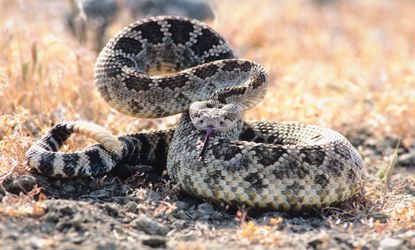How snakes use GPS to find their prey
The slithery predators have no problem locating escaped prey after it's been poisoned. Now scientists think they know how.

Somewhere in the underbrush of a forest a snake sits and waits, coiled around itself, perfectly still and quiet.
A mouse scurries by. In the blink of an eye the snake darts out, biting the mouse and injecting it with a large dose of venom. Once the dirty work is done, a venomous snake has two choices. Some, like the king cobra, use a "strike-and-hold" technique, retaining the prey in their mouth until the animal succumbs to the toxins. This keeps the meal close at hand, but is risky for the snake. The prey might fight back in its last moments of life, or the snake could be caught off-guard by a larger predator during the struggle.
Other snakes, like rattlesnakes, instead use a "strike-and-release" technique. They bite an animal and deliver the venom, and then disengage and wait for the toxins do their thing. It's safer for the snake, but if the animal flees before dying, the snake has to go through the trouble of finding it again before it can eat.
Subscribe to The Week
Escape your echo chamber. Get the facts behind the news, plus analysis from multiple perspectives.

Sign up for The Week's Free Newsletters
From our morning news briefing to a weekly Good News Newsletter, get the best of The Week delivered directly to your inbox.
From our morning news briefing to a weekly Good News Newsletter, get the best of The Week delivered directly to your inbox.
Scientists know from watching snakes in the lab and in the wild that they have few problems tracking down bitten prey again. But they weren't sure exactly how the predators suddenly became master trackers. New research from biologists in Colorado reveals one trick that snakes have for locating and finishing their meals: A pair of proteins in their venom that "tag" the prey like a LoJack on a car, providing a chemical tracker that hungry snakes can follow.
When an animal escapes, the snake searches for it while flicking its tongue to pick up chemicals in the air and sniff out the animal's trail. No one was sure exactly what gave away the prey's location, though. Urine, scent molecules, and alarm pheromones from prey animals have all been tested, but snakes didn't respond to any of these.
Stephen Mackessy and a team of researchers from the University of Northern Colorado and the University of Colorado at Boulder took a different approach, and looked to see if the chemical tracking device was inside snake's venom instead of whatever it was hunting. They extracted venom from a group of western diamondback rattlesnakes, and broke down the poison into smaller component parts. Next, they injected either the whole venom, the venom fractions, or water into different mice. The rodents were then placed in the snakes' cages.
Researchers observed that snakes flicked their tongue more when searching for animals already loaded with the poison, suggesting that whatever was tipping the snakes off to their prey's location was in their venom. The rattlers also responded more to one venom fraction than the others (and even more than the whole venom), flicking their tongues with more frequency as they sought out the injected mouse.
Sign up for Today's Best Articles in your inbox
A free daily email with the biggest news stories of the day – and the best features from TheWeek.com
When the researchers analyzed the fraction, they isolated two proteins known as disintegrins. Their primary role in venom is to prevent the prey's blood from clotting after it's bitten. But the snakes' reaction to the venom fractions suggests that disintegrin is the chemical GPS that some snakes use to hunt down the mouse that got away.
Mackessy still isn't sure how the disintegrin proteins create a "tag" that the snakes can track. They might work on their own (they make up only 2 percent of the total venom, and this could explain why many venomous snakes inject far more venom than is needed to kill their normally small meals), or they might interact with other chemicals in the prey's body to create cues for the snakes to follow. Mackessy and his team are exploring these questions in new experiments now.
Create an account with the same email registered to your subscription to unlock access.
-
 Why au pairs might become a thing of the past
Why au pairs might become a thing of the pastUnder The Radar Brexit and wage ruling are threatening the 'mutually beneficial arrangement'
By Chas Newkey-Burden, The Week UK Published
-
 'A direct, protracted war with Israel is not something Iran is equipped to fight'
'A direct, protracted war with Israel is not something Iran is equipped to fight'Instant Opinion Opinion, comment and editorials of the day
By Harold Maass, The Week US Published
-
 Today's political cartoons - April 17, 2024
Today's political cartoons - April 17, 2024Cartoons Wednesday's cartoons - political anxiety, jury sorting hat, and more
By The Week US Published